Iren Dabasu Formation
The Iren Dabasu Formation (also known as Erlian Formation) is a Late Cretaceous (Cenomanian) geologic formation in the Iren Nor region of Inner Mongolia. Dinosaur remains diagnostic to the genus level are among the fossils that have been recovered from the formation. The formation was first described and defined by Henry Fairfield Osborn in 1922 and it is located in the Iren Nor region of China.[1]
| Iren Dabasu Formation Stratigraphic range: Cenomanian ~96 Ma | |
|---|---|
| Type | Geological formation |
| Unit of | Paysandú Group |
| Overlies | Arshanto Formation |
| Area | Erenhot (Erlian) city |
| Thickness | Up to 500 m (1,600 ft) |
| Lithology | |
| Primary | Sandstone, claystone, siltstone |
| Other | Glutenite |
| Location | |
| Coordinates | 43.8°N 112.4°E |
| Approximate paleocoordinates | 43.1°N 101.0°E |
| Region | Inner Mongolia |
| Country | |
| Extent | Erlian Basin |
| Type section | |
| Named for | Iren Dabasu |
| Named by | Osborn |
| Year defined | 1922 |
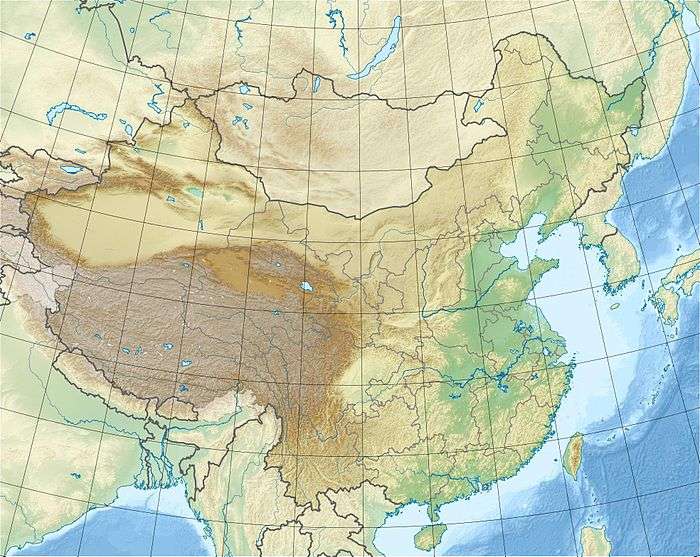 Iren Dabasu Formation (China) 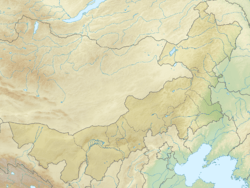 Iren Dabasu Formation (Inner Mongolia) | |
Geology
It comprises continental clastic sediments consisting of light grey fine sandstones, coarse sandstones and glutenites as well as mottled claystones and siltstones. The fine-grained floodplain sediments and the coarse-grained sediments of the point bar formed a series of repeated frequently binary sedimentary rhythms. The “binary structure” of the sedimentary rhythms strongly indicates meandering stream deposits rather than braided river deposits as previously thought.[2][3] As indicated by the fluvial and lacustrine sedimentation, the Iren Dabasu Formation was a large floodplain terrain with braided rivers and meanders that suppoted extensive vegetation, evidenced on the prominent palaeosol development and the numerous remains from herbivorous dinosaurs.[3][2] Egg nests, caliche and paleosols seem to indicate periodic subaerial intervals, in addition, the presence of plesiosaur and hybodont shark remains (which are also known in the Bayan Shireh Formation) are indicatives of a river system with connections to the ocean.[4]
Correlations
Based on the ostracod and charophyte assemblages of the Iren Dabasu Formation, Itterbeeck et al. 2015 suggested a potential correlation with those of the Nemegt Formation, making its age Late Campanian to Early Maastrichtian.[3] However, vertebrates point to an older date than the Campanian-Maastrichtian ages, the supposed deposition of ostracods is likely due to climatic conditions rather than age.[5] The turtle Khunnuchelys is known from both Iren Dabasu and Bayan Shireh equivalent units such as the Bostobe and Bissekty.[2] In addition, a giant caenagnathid similar to Gigantoraptor is now known from the Bayan Shireh Formation at the locality of Tsagan Teg.[5] Like the coeval Bayan Shireh Formation (and possibly Javkhlant Formation) in the Gobi Desert, the dinosaur fauna of the Iren Dabasu Formation includes tyrannosauroids, ornithomimids, therizinosaurs and oviraptorosaurs.[6]
However, strong evidence coming from biostratigraphic occurrences seems to support a correlation with the Bayan Shireh Formation, at least, with the upper boundary. For instance, both formations bear similar dinosaur taxa, such as therizinosaurs (Erlikosaurus, Segnosaurus, Erliansaurus or Neimongosaurus) and ornithomimosaurs (Garudimimus or Archaeornithomimus), these similirities are even more intensified by the discovery of Gigantoraptor and the giant unnamed caenagnathid from Bayan Shireh. In addition, the potential discovery of Alectrosaurus in both formations seems to be another indicative of a correlation.[7][2][5] Consequently, Averianov and Sues estimated the formation to be Santonian in age, roughly about 86 million and 83 million years ago.[2] Guo et al. 2018 also supported a Cenomanian age based on U–Pb, paleomagnetic and biostratigraphic analyses, around 95.8 ± 6.2 million years ago.[8]
Fossil content
The Iren Dabasu Formation is rich on dinosaur fauna, with multiple species described, in the other hand, mammals seem to be extremely absent. Compared, the fossil taxa between Iren Dabasu and Bayan Shireh are very similar, most notably therizinosaurs, tyrannosauroids, oviraptorosaurs and turtles.[9][2] Although Gigantoraptor is the only described oviraptorosaur from the formation, Funston et al. 2019 described a new avimimid bonebed containing numerous individuals at different growth stages. Nevertheless, the fossils lacked enough diagnosis to be confined to a separate genus and species.[4] Deinonychosaurs are not very common across the formation, however an indeterminate troodontid about the size of Saurornithoides is known from three isolated specimens.[10]
Color key
|
Notes Uncertain or tentative taxa are in small text; |
Dinosaurs
Theropods
| Theropods reported from the Iren Dabasu Formation | ||||||
|---|---|---|---|---|---|---|
| Genus | Species | Location | Stratigraphic Position | Material | Notes | Images |
| A. olseni |
"Virtually complete right hindlimb and left metatarsals."[11] |
A tyrannosauroid. Potentially present in the Bayan Shireh Formation |
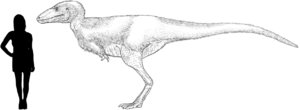 | |||
| A. asiaticus |
"Partial manus, metatarsus, vertebrae, limb elements."[11] |
An ornithomimosaur originally identified as Ornithomimus. |
 | |||
|
Avimimidae spp. |
Indeterminate |
"Vertebrae and postcranial elements represented by at least six individuals."[4] |
Avimimids at different growth stages. |
 | ||
|
Caenagnathasia spp. |
Indeterminate |
"Beak from lower jaws."[12] |
An oviraptorosaur. |
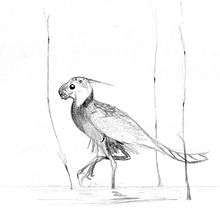 | ||
| E. bellamanus |
"Cervical vertebrae and postcranial elements."[13] |
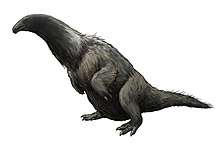 | ||||
| G. erlianensis |
"Lower jaws and much of the postcranial elements with very elongated hindlimbs."[14] |
A giant oviraptorosaur. |
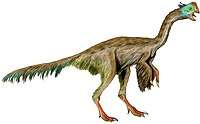 | |||
| N. yangi |
"Two specimens with most of the axial column, many limb and girdle elements, and a partial dentary."[15] |
A therizinosauroid. |
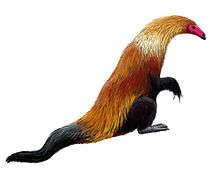 | |||
|
Therizinosauridae spp. |
Indeterminate |
A therizinosaurid similar to Segnosaurus. |
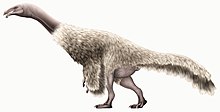 | |||
|
Troodontidae spp. |
Indeterminate |
"Right and left metatarsals represented by three specimens."[10] |
A troodontid. |
.jpg) | ||
Ornithopods
| Ornithopods reported from the Iren Dabasu Formation | ||||||
|---|---|---|---|---|---|---|
| Genus | Species | Location | Stratigraphic Position | Material | Notes | Images |
|
B. johnsoni |
"Cranial and postcranial material represented by more than eight specimens."[11][17][18] |
A hadrosauroid. |
||||
|
G. mongoliensis |
"Partial cranial and postcranial elements represented by more than ten specimens".[11][19][18] |
A hadrosauroid originally identified as Mandschurosaurus. |
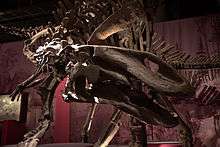 | |||
|
S. irenensis |
"Egg fossils."[20] |
Eggs shells attributed to Spheroolithus. | 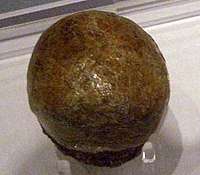 | |||
Sauropods
| Sauropods reported from the Iren Dabasu Formation | ||||||
|---|---|---|---|---|---|---|
| Genus | Species | Location | Stratigraphic Position | Material | Notes | Images |
| S. saihangaobiensis |
"Numerous cervical, dorsal and caudal vertebrae and some postcranial elements."[21] |
A titanosaur. |
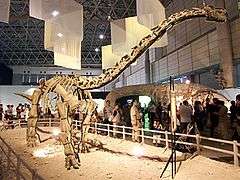 | |||
Flora
Angiosperms
| Angiosperms reported from the Iren Dabasu Formation | ||||||
|---|---|---|---|---|---|---|
| Genus | Species | Location | Stratigraphic Position | Material | Notes | Images |
| Indeterminate | "Pollen grain."[22] | |||||
|
Buttinia sp. |
Indeterminate | "Spores and pollen."[22] |
Angiosperm pollen. |
|||
|
Cranwellia sp. |
Indeterminate | "Pollen grain."[22] |
Angiosperm pollen. |
|||
|
Momipites sp. |
Indeterminate | "Pollen grain."[22] |
Angiosperm pollen. |
|||
|
Normapolles sp. |
Indeterminate | "Pollen grain."[22] |
Angiosperm pollen. |
|||
|
Sabalpollenites sp. |
Indeterminate | "Pollen grain."[22] |
Angiosperm pollen. |
|||
|
Tricolpate-morph |
Indeterminate | "Pollen grain."[22] |
Angiosperm palynomorph. |
|||
|
Triporate-morph |
Indeterminate | "Pollen grain."[22] |
Angiosperm palynomorph. |
|||
|
Ulmideipites sp. |
Indeterminate | "Pollen grain."[22] |
Angiosperm pollen. |
|||
|
Ulmipollenites sp. |
Indeterminate | "Spores and pollen."[22] |
Angiosperm pollen. |
|||
Gymnosperms
| Gymnosperms reported from the Iren Dabasu Formation | ||||||
|---|---|---|---|---|---|---|
| Genus | Species | Location | Stratigraphic Position | Material | Notes | Images |
|
Bisaccate-morph |
Indeterminate | "Spores and pollen."[22] |
Gymnosperm palynomorph. |
|||
|
Cerebropollenites sp. |
Indeterminate | "Pollen grain."[22] |
Gymnosperm pollen. |
|||
|
Cheirolepidiacean-morph |
Indeterminate | "Pollen grain."[22] |
Gymnosperm palynomorph. |
|||
|
Ephedripites sp. |
Indeterminate | "Spores and pollen."[22] |
Gymnosperm pollen. |
|||
|
Exesipollenites sp. |
Indeterminate | "Spores and pollen."[22] |
Gymnosperm pollen. |
|||
|
Monosulcate-morph |
Indeterminate | "Pollen grain."[22] |
Gymnosperm pollen. |
|||
|
Taxodiaceaepollenites sp. |
Indeterminate | "Pollen grain."[22] |
Gymnosperm pollen. |
|||
Spores
| Spores reported from the Iren Dabasu Formation | ||||||
|---|---|---|---|---|---|---|
| Genus | Species | Location | Stratigraphic Position | Material | Notes | Images |
|
Cyathidites sp. |
Indeterminate | "Spores and pollen grain."[22] |
Spore palynomorph. |
|||
|
Ischyosporites sp. |
Indeterminate | "Spores."[22] |
Spore palynomorph. |
|||
|
Leptolepidites sp. |
Indeterminate | "Spores."[22] |
Spore palynomorph. |
|||
|
Triplanosporites sp. |
Indeterminate | "Spores."[22] |
Spore palynomorph. |
|||
See also
- List of dinosaur-bearing rock formations
- List of Asian dinosaurs
- Laurasia
- Geology of Mongolia
- Cretaceous Mongolia
References
- Osborn, H. F. (1922). "Discovery of Cretaceous and older Tertiary strata in Mongolia" (PDF). Science. 56 (1446): 291–293. doi:10.1126/science.56.1446.291. PMID 17842026.
- Averianov, A.; Sues, H. (2012). "Correlation of Late Cretaceous continental vertebrate assemblages in Middle and Central Asia" (PDF). Journal of Stratigraphy. 36 (2): 462–485.
- Van Itterbeeck, J.; Horne, D. J.; Bultynck, P.; Vandenberghe, N. (2005). "Stratigraphy and palaeoenvironment of the dinosaur-bearing Upper Cretaceous Iren Dabasu Formation, Inner Mongolia, People's Republic of China". Cretaceous Research. 26 (4): 699–725. doi:10.1016/j.cretres.2005.03.004.
- Funston, G. F.; Currie, P. J.; Ryan, M. J.; Dong, Z.-M. (2019). "Birdlike growth and mixed-age flocks in avimimids (Theropoda, Oviraptorosauria)". Scientific Reports. 9 (18816). doi:10.1038/s41598-019-55038-5. PMC 6906459. PMID 31827127.
- Tsuihiji, T.; Watabe, M.; Barsbold, R.; Tsogtbaatar, K. (2015). "A gigantic caenagnathid oviraptorosaurian (Dinosauria: Theropoda) from the Upper Cretaceous of the Gobi Desert, Mongolia". Cretaceous Research. 56: 60–65. doi:10.1016/j.cretres.2015.03.007.
- Xing, H.; He, Y.; Li, L.; Xi, D. (2012). "A review on the study of the stratigraphy, sedimentology, and paleontology of the Iren Dabasu Formation, Inner Mongolia". In Wei, D. (ed.). Proceedings of the Thirteenth Annual Meeting of the Chinese Society of Vertebrate Paleontology (in Chinese). Beijing: China Ocean Press. pp. 1–44.
- Perle, A. (1977). "O pervoy nakhodke Alektrozavra (Tyrannosauridae, Theropoda) iz pozdnego Mela Mongolii" [On the first discovery of Alectrosaurus (Tyrannosauridae, Theropoda) in the Late Cretaceous of Mongolia]. Shinzhlekh Ukhaany Akademi Geologiin Khureelen (in Russian). 3 (3): 104–113.
- Guo, Z. X.; Shi, Y. P.; Yang, Y. T.; Jiang, S. Q.; Li, L. B.; Zhao, Z. G. (2018). "Inversion of the Erlian Basin (NE China) in the early Late Cretaceous: Implications for the collision of the Okhotomorsk Block with East Asia" (PDF). Journal of Asian Earth Sciences. 154: 49–66. doi:10.1016/j.jseaes.2017.12.007.
- Currie, P. J.; Eberth, D. A. (1993). "Palaeontology, sedimentology and palaeoecology of the Iren Dabasu Formation (Upper Cretaceous), Inner Mongolia, People's Republic of China". Cretaceous Research. 14 (2): 127−144. doi:10.1006/cres.1993.1011.
- Currie, P. J.; Zhiming, D. (2001). "New information on Cretaceous troodontids (Dinosauria, Theropoda) from the People's Republic of China". Canadian Journal of Earth Sciences. 38 (12): 1753–1766. doi:10.1139/e01-065.
- Gilmore, C. W. (1933). "On the dinosaurian fauna of the Iren Dabasu Formation". Bulletin of the American Museum of Natural History. 67 (2): 23–78. hdl:2246/355.
- Yao, X.; Wang, X. L.; Sullivan, C.; Wang, S.; Stidham, T.; Xu, X. (2015). "Caenagnathasia sp. (Theropoda: Oviraptorosauria) from the Iren Dabasu Formation (Upper Cretaceous: Campanian) of Erenhot, Nei Mongol, China" (PDF). Vertebrata PalAsiatica. 53 (4): 291–298.
- Xu, X.; Zhang, Z. H.; Sereno, P. C.; Zhao, X. J.; Kuang, X. W.; Han, J.; Tan, L. (2002). "A new therizinosauroid (Dinosauria, Theropoda) from the Upper Cretaceous Iren Dabasu Formation of Nei Mongol" (PDF). Vertebrata PalAsiatica. 40: 228–240.
- Xing, X.; Tan, Q.; Wang, J.; Zhao, X.; Tan, L. (2007). "A gigantic bird-like dinosaur from the Late Cretaceous of China". Nature. 447 (7146): 844–847. doi:10.1038/nature05849. PMID 17565365. Supplementary Information
- Zhang, X. H.; Xu, X.; Zhao, Z. J.; Sereno, P. C.; Kuang, X. W.; Tan, L. (2001). "A long-necked therizinosauroid dinosaur from the Upper Cretaceous Iren Dabasu Formation of Nei Mongol, People's Republic of China" (PDF). Vertebrata PalAsiatica. 39 (4): 282–290.
- Mader, B. J.; Bradley, R. L. (1989). "A redescription and revised diagnosis of the syntypes of the Mongolian tyrannosaur Alectrosaurus olseni". Journal of Vertebrate Paleontology. 9 (1): 41–55. doi:10.1080/02724634.1989.10011737.
- Godefroit, P.; Dong, Z. M.; Bultynck, P.; Li., H.; Feng, L. (1998). "New Bactrosaurus (Dinosauria: Hadrosauroidea) material from Iren Dabasu (Inner Mongolia, P.R. China)". Bulletin de l'Institut Royal des Sciences Naturelles de Belqique, Sciences de la Terre. 68: 3–70.
- Rothschild, B. M.; Tanke, D. H.; Helbling II, M.; Martin, L. D. (2003). "Epidemiologic study of tumors in dinosaurs". Naturwissenschaften. 90 (11): 495–500. doi:10.1007/s00114-003-0473-9. PMID 14610645.
- Prieto-Márquez, A.; Norell, M. A. (2010). "Anatomy and relationships of Gilmoreosaurus mongoliensis (Dinosauria, Hadrosauroidea) from the late Cretaceous of Central Asia". American Museum Novitates (3694): 1–49. hdl:2246/6080.
- Chao, T. K.; Chiang, T. K. (1974). "Microscopic studies on the dinosaurian egg-shells from Laiyang, Shanting province". Scientia Sinica. 17 (11): 73−90.
- Xu, X.; Zhang, X.; Tan, Q.; Zhao, X.; Tan, L. (2010). "A new titanosaurian sauropod from Late Cretaceous of Nei Mongol, China". Acta Geologica Sinica. 80 (1): 20–26. doi:10.1111/j.1755-6724.2006.tb00790.x.
- Bonnetti, C.; Malartre, F.; Huault, V.; Cuney, M.; Bourlange, S.; Liu, X.; Peng, Y. (2014). "Sedimentology, stratigraphy and palynological occurrences of the late Cretaceous Erlian Formation, Erlian Basin, Inner Mongolia, People's Republic of China". Cretaceous Research. 48: 177–192. doi:10.1016/j.cretres.2013.09.013.